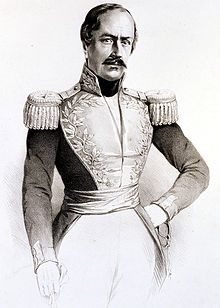José María Obando
| José María Obando | |
|---|---|

Drawing by José María Espinosa Prieto, c 1843.
|
|
| 10th President of the Republic of the New Granada | |
|
In office April 1, 1853 – April 17, 1854 |
|
| Preceded by | José Hilario López |
| Succeeded by | José María Melo |
| Member of the Colombian Chamber of Representatives | |
|
In office 1849–1853 |
|
| Constituency | Province of Bogotá |
| 1st Vice President of the Republic of the New Granada | |
|
In office November 23, 1831 – March 10, 1832 |
|
| President | None |
| Preceded by | Domingo Caycedo |
| Succeeded by | José Ignacio de Márquez |
| 6th Secretary of War and Navy | |
|
In office 1831–1831 |
|
| President | Domingo Caycedo |
| Preceded by | José Miguel Pey |
| Succeeded by | José Hilario López |
| Personal details | |
| Born |
José María Ramón Iragorri de Lemos Crespo August 8, 1795 Miranda, Cauca, Viceroyalty of the New Granada |
| Died | April 29, 1861 (aged 65) El Rosal, Cundinamarca, Granadine Confederation |
| Nationality | Neogranadine |
| Political party | Liberal |
| Spouse(s) | Dolores Espinosa de los Monteros Mesa (1824–1833) Timotea Carvajal Marulanda (1837–1861) |
| Religion | Roman Catholic |
José María Ramón Obando del Campo (August 8, 1795 – April 29, 1861) was a Neogranadine General and politician who twice served as President of Colombia. As a General, he initially fought for the Royalist Army during the Independence Wars of Colombia, ultimately joining the revolutionary forces of Simón Bolívar towards the end, but once independence was attained he opposed Bolívar's Centralist government.
Born out of wedlock to Ana María Crespo on August 8, 1795 in the town of Güengüe, municipality of Corinto, in the then Province of Popayán of the Viceroyalty of New Granada in present-day Colombia, he was baptised José María Ramón Iragorri Crespo just two days later on August 10 in the chapel of the García hacienda. Society, during the times of the colony, was puritanical and the religious authorities did not allow a single mother to raise a child on her own, thus when he was two years old he was given up for adoption and put in the care of a Criollo family in the home of Juan Luis Obando del Castillo y Frías and Antonia del Campo y López who raised him as their own and gave him their last name. His parentage has been of debate among historians, most argue that he was the illegitimate son of Joseph Iragorri, but others argue and have tried to prove that his father was Pedro Vicente Martínez y Cabal, and others have claimed that he was the biological son of his adoptive father Juan Luis Obando as well.
Despite his humble beginnings, Obando received a formal education in the Real Seminario de Popayán thanks to his adoptive family who were well-off merchants from Pasto loyal to the Spanish Empire and who consequently had to escape to Pasto after the Battle of Palacé (1811) during the Wars of Independence. Obando married Dolores Espinosa de los Monteros Mesa in 1824 and together had five children: José María, Cornelia, José Dolores, Simón and Micaela, it would have been six since Mrs. Espinosa was pregnant with another child, but both died during childbirth in 1833 leaving him a widower with five small children at his charge. In 1837 he remarries to Timotea Carvajal Marulanda and of this union has three more children: Soledad, Capitolino and Gratiniano.
...
Wikipedia
